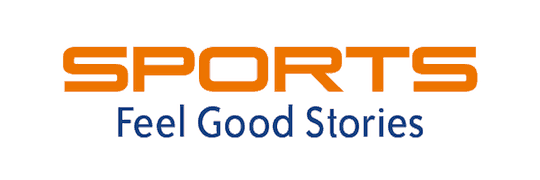Pickleball is a relatively new game for most players and fans despite being invented in 1965.
To understand and appreciate the game, it helps to understand the terms and definitions widely used on the court and in broadcast coverage of the sport. This is where our Sports Feel Good Stories Pickleball Dictionary can help.
For your reading interest, we’ve included some of the traditional terms associated with play and some of the pickleball lingo used. As more and more players learn the game – it is the fastest-growing sport in the U.S. (mandatory mention included in every pickleball article in the last two years) – we’ll be adding to our dictionary along the way.
So check it out, and check back frequently.
Pickleball Definitions: A — C
Our pickleball dictionary features alphabetically sorted terms to find a specific term you’re looking for quickly. We’ll update this dictionary as new definitions are added to the game. Please check back and use this as a resource.
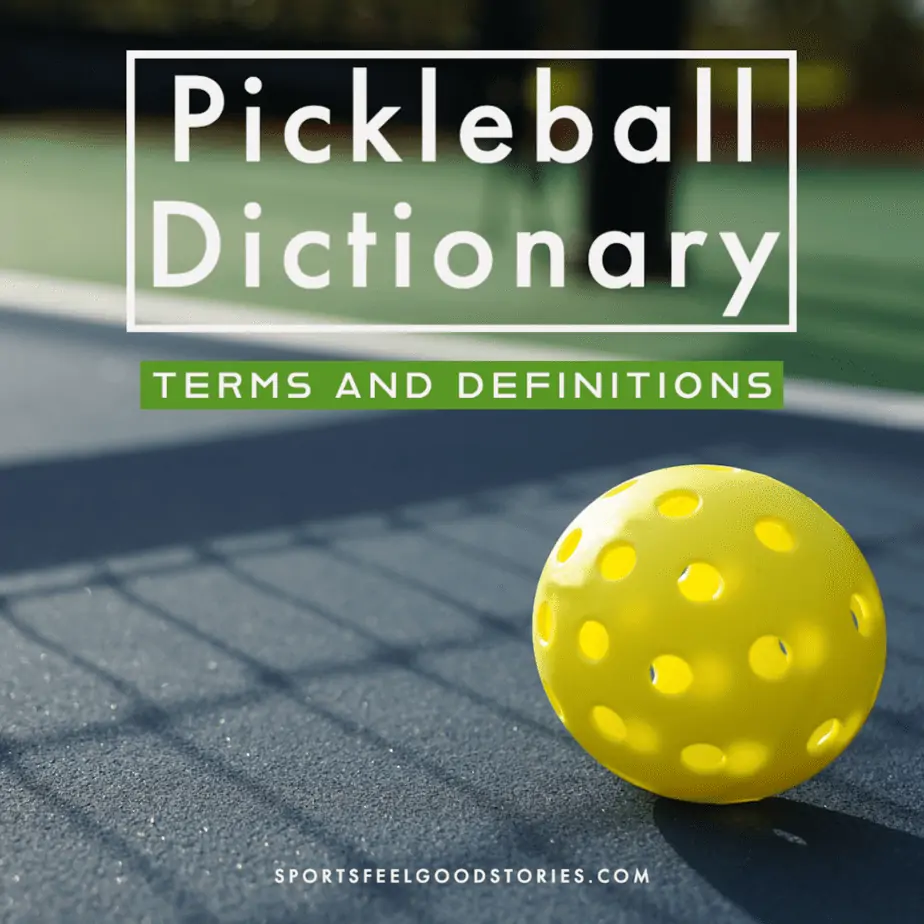
0-0-2
The opening score of a pickleball game. The first zero refers to the server’s score. The second zero refers to the receiver’s score. And the two refer to this being the second serve (usually of two serves, but in this case, the first server only gets one serve).
Around The Post (ATP)
An “Around The Post” is where a player can return a shot to an opponent’s court without having the ball go over the net. It’s a legal shot that occurs when the opponent pushes the hitter of the ATP to the far side of the court. Because the ball doesn’t have to go over the net, it is usually struck lower than the net level.
See 225 Best Pickleball Team Names.
Ace
When a server hits a legal serve that is not touched by the receiver before the second bounce resulting in a point for the server or serving team.
Ad Court
A carryover from tennis, the ad court refers to the left side of a pickleball court. See “Odd Court.”
Approach Shot
An approach shot is an offensive pickleball shot struck with the purpose of transitioning to the kitchen line to try and close out a point. Typically, an approach shot is attempted after a shorter opponent’s shots or for returns of serves.
See Interesting Pickleball Quotes.
At’ em Ball
An offensive shot aimed directly at a player at the kitchen line, usually at a hard speed. The goal of the shot is to win the point quickly. It is frequently employed when a player is within the baseline, so the defender has less time to prepare.
By aiming the ball right “at ’em,” the defender might have a hard time returning the ball with a backhand or forehand volley.
See 43 Pickleball Strategies and Tips to improve your game.
Backcourt
The area near the baseline – roughly three feet on either side of the baseline. From the backcourt, players are traditionally hitting groundstrokes.
Backhand
A type of stroke where the paddle moves across the player’s body with the back of the hand moving towards the opponent’s court on the follow-through.
Backspin
Also called slicing the ball or underspin, a player generates backspin by moving the paddle down at an angle upon contacting the ball. This causes the pickleball to roll backward and, when contacting the opponent’s court surface, will stay down, and if not countered, more likely for the return to hit the net.
Standard counters to backspin shots include hitting the return with topspin, aiming the trajectory of the ball higher, or hitting the return with backspin.
See 10 Pickleball Tips For Tennis Players.
Backswing
The backswing is the backward motion of striking a pickleball that moves the paddle into position to prepare to swing forward and hit the ball. Relative to tennis, the pickleball backswing is shorter (because the court is smaller).
Banger
A player who likes to hit the ball hard to overpower opponents to win points. Typically, a banger will hit drives and volleys more than dinks and drop shots. When playing against a banger, one piece of advice: be alert for shots that are going long (and let them go long).
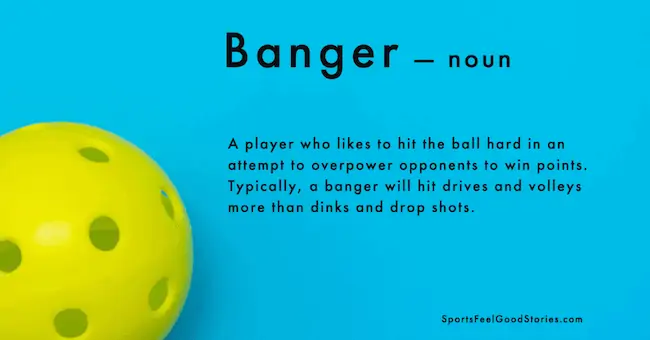
Baseline
A court marking that runs parallel to the net at the end of each court. Each baseline is 20 feet wide from sideline to sideline.
Bounce It!
The expression “Bounce it!” is a frequently heard pickleball communication between partners where the players suggest that their partners let the pickleballs bounce — usually because they think the ball will be out of bounds.
Bounce Serve
Also known as a drop serve. A bounce serve enables the server, with feet behind the baseline and an imaginary extension of the centerline and sidelines, to bounce the ball before serving. The ball can be bounced anywhere on the court but cannot be tossed up or pushed down — it must be dropped.
With a bounce serve, the three rules of service motion no longer need to be followed — ball struck beneath the waist, upward movement, and paddle head below the wrist.
Carbon Fiber
Carbon fiber is a common surface material for premium pickleball paddles. The material is stiff, which provides players with a good sense of control. Relative to fiberglass, another common surface material for paddles, carbon fiber is noted for better control but less power.
Carry
When a ball is hit unintentionally twice, it appears as if it’s being carried over the net. In pickleball, this shot is legal if the player’s stroke is “one continuous motion.”
Centerline
The line on each side of the net bisects the area between the kitchen (non-volley zone) and the baseline.
Champion Shot
A ball that bounces twice in the Non-Volley Zone.
Chop
A stroke in pickleball in which the player hits the ball with a backspin. It can be accomplished as a volley or as a groundstroke.
Court Dimensions
A pickleball court’s lined dimensions are 44 feet long by 20 feet wide. However, if you were thinking about constructing a court in your backyard or at a park, you’d want to add 12 feet to each end and six feet to each side. This would make the entire concrete or asphalt mat 68 feet long by 32 feet wide.
See more Pickleball Court Dimensions and rules.
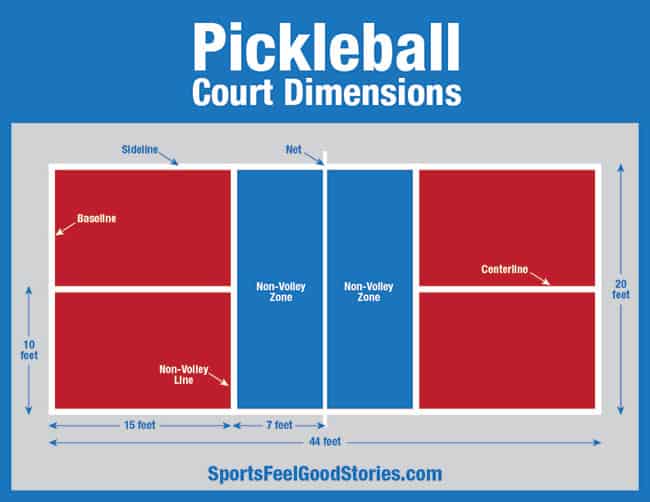
Cross-Court
To strike the ball from the even courtside to the odd courtside, or visa-versa. It is generally considered easier to hit cross-court shots because the net’s height is shorter in the middle of the court – by two inches – than in the areas of the court nearer the net posts.
Cutthroat
A three-player pickleball game in which one player is matched up against two players. On the lone player’s side, you may choose to have that player cover the entire court or just the side that the player serves from.
Each player has their own scorer. And, after each server’s serve is broken – one serve for the first server and two after that – players rotate so that each player individually serves from the single-player side. Three scores are called out in addition to the serve number, so the open score is 0-0-0-2.
Pickleball Lingo: D — F
Here are some more terms commonly used in pickleball.
Dairy Queen (or DQ)
A soft serve with a high loft. Dairy Queen is noted for its soft-serve ice cream. The term was popularized at Marie Courts in Mendota Heights, Minnesota.
Dead Ball
A dead ball occurs when a player commits a fault, hits a permanent object (like a ceiling), or a hinder is declared. In the case of a player committing a fault, the other side wins the point.
Deuce Court
A carryover from tennis: The right side of a pickleball court. See “Even Court.”
Dillball
An infrequently used term in some pickleball circles refers to a live ball that has bounced once and is inbounds.
Dink Shot
A ball strikes softly and arcs over the net into the opposing team’s kitchen. Dink shots are part of the short game of four players standing at the non-volley zone line and dropping short shots over the net until an error of some kind is made.
Dinker
It refers to a pickleball player who likes the dinking game.
Divorce Alley
The area between two double partners is particularly appealing for opposing teams to direct shots at because each player may think the other will hit the ball.
Down-the-Line Shot
A shot in pickleball that runs parallel to, or near to, one of the sidelines. This type of shot never crosses the centerline.
Double Bounce
Also known as the Two Bounce Rule. The first rule of pickleball: The receiving team must let the ball bounce when served, and then the serving team must let the return bounce when hit back.
Those are the two bounces. With that rule, the first team that can legally hit a volley is the returning team.
Doubles
When two players play two opponents, this is the predominant game variation for pickleball.
Drive
A drive in pickleball is a hard, fast shot.
Drop Shot
A soft shot is usually intended to land in the kitchen. Think of a long dink shot being a drop shot. The shot is aimed short of an opponent’s position. The positive part of the shot is that it can be challenging to reach. The negative aspect is that if an opponent gets the shot and successfully returns it, you’ve brought the opponent right up to the kitchen line – a better position to win points than the backcourt.
Drop Spin
A drop shot hit will backspin. The backspin helps keep the ball low and makes it more challenging to play.
Drop Shot Volley
A ball hit in the air that is not intended to travel far. Instead, the goal is usually to position the ball in or near the kitchen area.
Edge Guard
A protective piece is built into a pickleball paddle to protect the core and prevent de-lamination. Typically edge guards are made of plastic, rubber, or some compound.
Elongated Pickleball Paddle
A standard size paddle length is 16”. So elongated refers to those paddles longer – usually 16.5” or 17”.
Erne Shot
An advanced pickleball shot where the player hits the ball either 1.) in the air as they jump around the kitchen lines or 2.) After establishing feet outside of the kitchen, just to the side of the kitchen.
The shot is named after Erne Perry, who popularized the shot in competitive play. So, it’s Erne, not Ernie.
Even Court
The first service begins on the right-hand side of each side of the court. In tennis, this side is referred to as the deuce court. For the first server, the score when that player is on this side throughout the game will be even, e.g., 0-2-4, etc.
Falafel
A shot that falls short because it was hit too softly.
Fault
Any action that stops play because of a rule violation. A fault by the receiving team results in a point for the serving team. A fault by the serving team results in a side out or loss of serve. Examples of faults include a serve that doesn’t land in the confines of a receiving court, a ball that is volleyed before it is allowed (before the second bounce has taken place), or when a ball is hit into the net on their serve or the return of serve.
Pickleball Lingo Meme
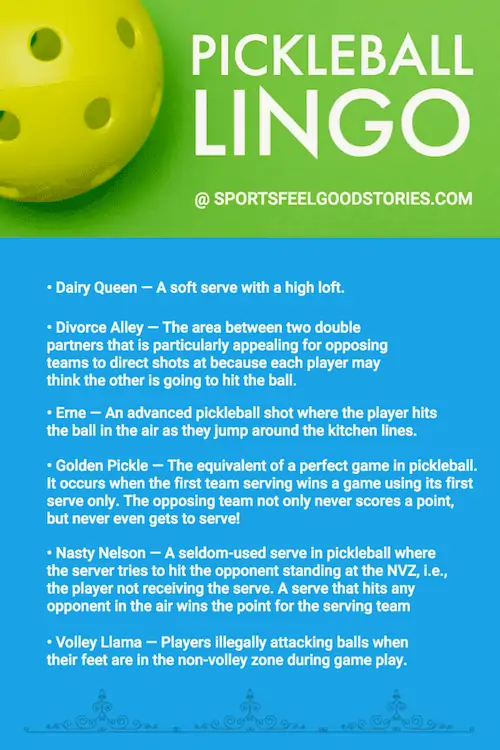
Fiberglass
A material for pickleball paddles that is noted for its ability to produce power.
Flapjack
A shot that must bounce before it can be hit legally.
Flat Shot
A ball that is hit with little or no spin.
Foot Fault
The most common foot fault is when the serves extend either foot beyond the baseline during serving. In addition to the baseline violation, a fault occurs when servers extend beyond the imaginary extension of the centerline or sideline.
Forehead
A type of stroke in pickleball where the paddle moves across the player’s body with the palm moving towards the opponent’s court on the follow-through.
Words Meaning: G — O
Every sport has its terminology. Pickleball is not different, although there’s quite a bit of crossover between tennis and pickleball.
Game
A regulation pickleball game is played to 11 points, with each team only winning points while serving. A team must win by two points, so there can be extended play, e.g., a team might win in overtime by a score of 15 – 13.
Grip
Refers to how you hold the pickleball paddle and the actual material and size of the area of the paddle handle that a player holds.
Golden Pickle
The equivalent of a perfect game of pickleball. It occurs when the first team serving wins a game using its first serve only. The opposing team never scores a point and never even gets to serve!
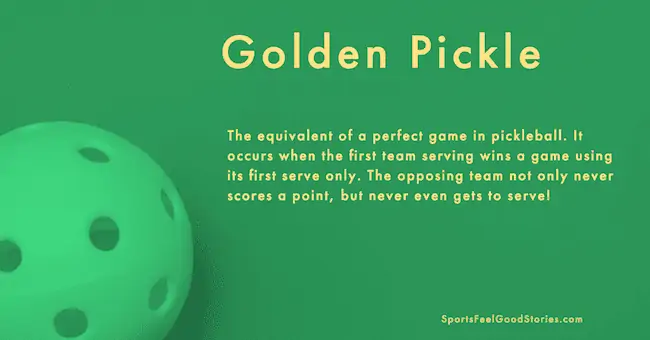
Ground Stroke
Refers to a shot a player makes after the ball bounces on the court that is not in or near the kitchen line. It can be a forehand or a backhand shot. Unlike the volley, a groundstroke shot is always struck after the ball bounces.
Half-Volley
Pickleball shots hit just after the ball bounces.
Kitchen
A slang term for the non-volley zone. It is much more commonly used than the non-volley zone (NVZ).
Lob
A lofted shot is typically intended to go over opponents’ heads and force them to back up from their NVZ line. It can be an effective offensive and defensive shot.
Nasty Nelson
A seldom-used serve where the server tries to hit the opponent standing at the NVZ, i.e., the player not receiving the serve. A serve that hits any opponent in the air wins a point for the serving team.
This tactic, perhaps appropriately named, is of questionable sportsmanship values. It was named after Tim Nelson.
Net Height
A pickleball net should be 34 inches in the middle and 36 inches high at the sidelines.
Net Posts
A permanent object that is placed out of bounds. A player that hits the net point loses that rally.
No Man’s Land
Also called the transition area, it is the court area between the Non-Volley Zone and the baseline.
Non-Volley Line
This line is on both sides of the net and runs parallel to the net. It is seven feet from the net.
Non-Volley Zone (NVZ)
Also, more informally called the kitchen. It refers to the seven feet on both sides of the net bordered by the sidelines, the net, and the non-volley line. Volleying, hitting the ball in the air, is prohibited in the NVZ.
Odd Court
The left side of the court on each side of the net. In tennis, this is referred to as the ad court.
One Continuous Motion
When a player double-hits a pickleball in play, the stroke is legal if it was made with one continuous motion — that is, there’s no stoppage between the first hit of the ball and the second.
Opa
An expression infrequently shouted out after the third shot has been hit to notify a partner that volleying can begin.
Overhead
An offensive shot is hit over the head off the forehand side in a motion similar to a tennis serve. An overhand shot is typically used to counter lobs.
Overhead Slam
A shot where the player swings high overhead and downwards in a forceful manner. Overhead slams are typically implemented against lobs and shots with a high bounce, especially ones close to the net.
Pickleball Terms: P — S
Learn more about the game as you learn these pickleball definitions.
Paddle
The instrument one uses to strike the ball. Please note tennis players: paddle terminology is preferred over racquet.
Paddle Surface Grit
The roughness of the paddle’s hitting area texture. This is significant because roughness helps a player generate spin. Pickleball associations, like the USAPA, regulate the amount of grit allowed for paddles.
Paddle Tap
Tapping the butt of your paddle’s handles is a traditional way to say “Good game” to your opponents and partner at the end of a game.
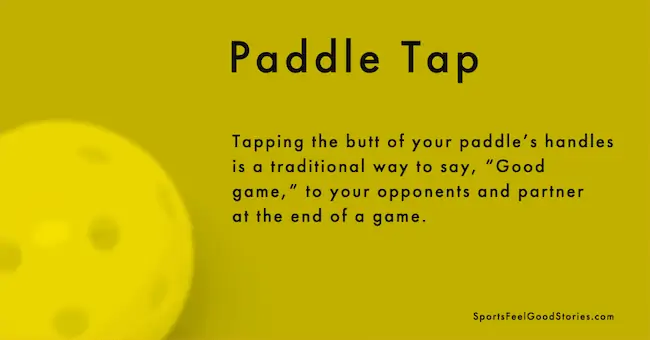
Passing Shot
Hitting a stroke results in the ball going past your opponent or opponents standing at the non-volley line.
Permanent Objects
Any object on or near the pickleball court has the potential to interfere with play. These might refer to net posts, light fixtures, walls, line judges, spectators, and many more items.
Pickle
Pickleball servers shout out an alert to notify players that they are about to serve.
Pickled
A slang term for getting zero points in a game against an opponent.
Pickleball
An outdoor or indoor game played on a court 20 feet wide and 44 feet long with paddles and a perforated plastic ball with rallies over a three feet high net (34” tall in the center). The object of the game is to win rallies and be the first to score 11 points. A player or team can only score while serving.
It also refers to the ball used in the sport.
Pickleball Addict
A player who can’t get enough of the game. Typically, goes to bed thinking about third shot drops.
Pickled
Losing 11-0. The equivalent of being skunked.
Pickledome
The court at a pickleball tournament where the championship match is played.
Pickler
Someone who plays pickleball and is likely obsessed with the game.
Pickles The Dog
The name of Joel Pritchard’s dog was Pickles. Pritchard was one of the original creators of pickleball. According to some founders of the sport, the name pickleball is derived from Pritchard’s dog.
Poach
When a player crosses the court centerline to hit a shot aimed at their partner’s side of the court, it is an aggressive maneuver intended to catch your opponent off-guard.
Poacher
One who frequently crosses the centerline to intercept shots directed at his or her’s partner.
Punch Volley
A short stroke with players typically standing at the kitchen line where they hit the ball before it bounces in a short compact manner.
Put Away
A shot that results in a team winning the point in a definitive manner.
Rally
Continuous play as opponents hit the ball over the net and back after the serve and before the point is concluded. It is also used to describe the warming-up activities that typically combine ground strokes and volley—hitting back and forth to prepare for a game.
Ready Position
The ideal starting position addresses how a pickleball player should stand and how to hold the paddle. When standing at the kitchen line, it is typically recommended to have your feet shoulder length apart, knees bent, with your paddle at chest height and in front of you. If you’re in the transitional area and the other team is ready to hit down on the ball, you’d typically move the paddle from chest height to closer to the ground.
Reset Shot
When the opposing team has hit a challenging shot or when your team is out of position, you might attempt a reset shot. The goal of the shot is to prevent the opponent from attacking and provide you and your partner time to regroup and prepare for the next shot. A reset shot is typically hit in or near the kitchen.
Service Court
The areas on either side of the centerline on both sides of the court are bounded by the baseline, the sideline, and the non=volley line.
Scorpion
A type of stroke where a player drops to lower the body to improve on a smash angle of a ball that is relatively high but not high enough to stand at full height and hit. The raised paddle looks like the tail of a scorpion.
Service Motion Rules
There are three rules for a volley serve. 1.) The ball must be struck underneath the server’s waist. 2.) There must be an upward motion on the serve. 3.) The paddle head must be under the wrist.
Shadowing
A strategy in doubles play where you and your partner maintain an agreed-on distance from each other to provide the best court coverage.
Shake and Bake
A strategy where player A on the serving team hits a hard drive on the third shot. Player B crashes in – moving even before the drive is executed – to the middle of the court in hopes of intercepting and hitting a winner off the return. If things go to plan, the return team will hit a weak volley, which player B anticipates and crushes.
Shoulder High, Let It Fly
An expression that directs players on whether or not to play high shots that come to them when they’re playing a return from the opposition. If you’re standing at the kitchen line, and the ball coming at you is at least shoulder-high, it’s usually best to let it go — with the thinking, it will go beyond the baseline, and you’ll win the point.
Sideline
The sidelines outline the vertical perimeter of a pickleball court. They are 44 feet in length and run perpendicular to the net.
Side-out
When both servers in doubles play have lost their serves, the service goes to the other team. This is a side-out.
Singles
One-on-one play in pickleball.
Skinny Singles
Playing one-on-one pickleball, but with only half the court.
See Pickleball Slogans and Sayings.
Slice
See backspin.
Smash
A hard overhead shot directed to your opponent’s court. Smash opportunities typically come from short overheads, high bouncing lobs, or high returns.
Soft Game
A style of pickleball play where a player returns the ball “softly” – without much speed or pace – into the non-volley zone. This might entail a series of dinks shots with all four players standing at the kitchen line.
Split Stance
Position your legs parallel to each other, and be in the ready position to hit a return. Split stance is used frequently to address the returner of a serve coming to the net. When this happens, and the serving team is nearly hitting the third shot, the player should jump into the split stance even if the player hasn’t arrived at the kitchen line. Instead of having one leg in front of the other, most pros recommend you quickly get into a split stance to be prepared to go left, right, forward, or backward.
Stacking
A court coverage strategy is where players are positioned in a non-traditional manner to keep one player (or both players) on a particular side of the court. For example, stacking may be used when left-handed player partners with a right-handed player, and both players would like their forehands to be in the middle of the court.
Stacking incorporates different starting positions than traditional spots for players.
Smash: a shot that is hit above the hitter’s head with a serve-like motion. It is also referred to as an overhead. Split Stance: Position with feet separate and parallel in the “ready position” to return the ball. Stroke: The swinging motion of striking the pickleball with the paddle (i.e., forehand stroke, backhand stroke, ground stroke). Technical Foul: In tournament play, the referee may add a point to a team’s score when the opponent violates one of the rules calling for a technical foul other than standard faults in play
Vocabulary for Pickleball: T — Z
It’s hard to believe there’s still more to learn about pickleball.
Third-Shot Drop
The 3rd shot drop, as the name suggests, is hit on the third shot of a rally by the serving team with the intent of dropping the ball into the kitchen area. As a common strategy among returning teams is to bring both players to the non-volley zone line, a practical third shot drop prevents the return team from hitting an attackable ball.
Most experts agree that mastering the third-shot drop is crucial to being an advanced pickleball player.
Topspin
Topspin refers to hitting the ball on the top half of the ball, propelling it forward, and causing it to bounce deeper and higher. It also increases the chance of a ball not going too far beyond the baseline or sideline because it causes the ball’s arc to go down more quickly than a flat shot.
Two-bounce Rule
See Double Bounce Rule.
Unattackable Shot
A shot hit across the net that your opponent cannot be aggressive with puts your team on the defensive. Pickleball legend Dave Weinbach has popularized this term.
Underspin
See backspin.
Unforced Error
A mistake made by a player that is not forced by an opponent’s good play, e.g., hitting a ball into the net when the opponent hits a short, soft return of serve.
Volley
Pickleball shots hit during a point without the ball bouncing.
Volley Llama
Players illegally attack balls when their feet are in the non-volley zone during gameplay.
Volley Serve
Striking a serve in the air without letting the ball bounce first. The volley serve is more popular than the bounce serves among advanced players.
Pickleball Terminology: Final Thoughts
Although all the terms and definitions listed above may seem daunting if you’re new to the game, pickleball and its vocabulary can be picked up very quickly.
Part of the sport’s appeal and rising popularity is that most players can learn the game on their first visit to the pickleball courts. Sure, you might not know everything after day one, but you’ll undoubtedly have a good start, especially if you play with someone who has played a bit.
So, I encourage you to go out and give pickleball a try. In addition to being easy to learn, it’s good for your health, and a study showed that people enjoy the game 150% more than just walking. The bottom line, pickleball is a fun sport.
By Mike O’Halloran
Mike is a former tennis instructor who has gravitated to playing pickleball. He has written four books on sports.
Overtime
You are on our Sports Feel Good Stories Pickleball Dictionary: Terms and Definitions page.
You might like:
